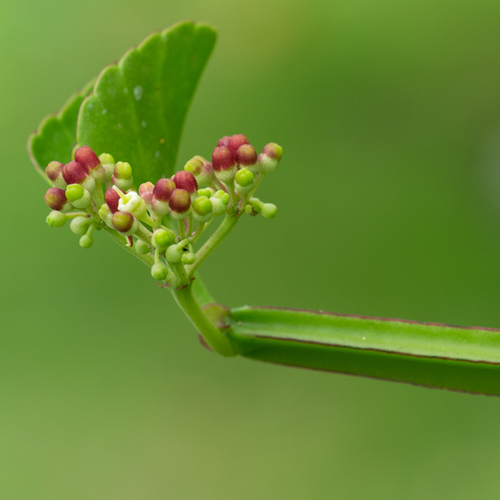
Cissus quadrangularis
Scientific names: Cissus quadrangularis, Vitis quadrangularis
Family: Vitaceae
Alternate names: Adamant Creeper, Asthisamdhani, Asthisamharaka, Asthisanghata, Asthisonhara, Bone setter, Chadhuri, Chaudhari, Cissus, Cissus Extract, Cissus Formula, Cissus Formulation, C. Quadrangularis, Cissus Quadrangularis Extract, Devil's Backbone, CORE, CQ, CQE, CQR-300, Extrait de Cissus, Hadjod, Hadjora, Harbhanga, Harishankar, Harsankari, Hasjora, Kandavalli, Kandavela, Mangaroli, Nalleru, Namunungwa, Patah Tulang, Phet Cha Sung Khaat, Phet Sang Kat, Phet Sangkhat, Pirandai, Quadrangularis, Samroi To, San Cha Khuat, Stemmed Vine, Vajrangi, Vajravalli, Vedhari, Veld Grape, Veldt Grape, Winged Treebine
Actions: Analgesic, Anti-inflammatory, Antimicrobial, Antineoplastic, Antioxidant, Antispasmodic, Bone, Gastrointestinal, Hemorrhoid, Hepatoprotective, Weight loss
Background
Cissus quadrangularis is a vine that grows in Africa and parts of Asia. Traditionally, its plant parts are dried and made into powder to use as medicine.
Cissus quadrangularis might have antioxidant, pain-relieving, and anti-inflammatory effects. It might also help stimulate bone growth.
People use Cissus quadrangularis for obesity, fractures, joint pain, low bone mass, and many other conditions, but there is no good scientific evidence to support most of these uses.
Cissus quadrangularis might have antioxidant, pain-relieving, and anti-inflammatory effects. It might also help stimulate bone growth.
People use Cissus quadrangularis for obesity, fractures, joint pain, low bone mass, and many other conditions, but there is no good scientific evidence to support most of these uses.
Safety Safety definitions
When taken by mouth: Cissus quadrangularis is possibly safe when used for up to 10 weeks. It's usually well-tolerated. Side effects might include headache, diarrhea, and insomnia.
Surgery: Cissus quadrangularis might lower blood sugar levels and could interfere with blood sugar control during and after surgical procedures. Stop using Cissus quadrangularis at least 2 weeks before a scheduled surgery.
Special Precautions & Warnings:
Pregnancy and breast-feeding: There isn't enough reliable information to know if Cissus quadrangularis is safe to use when pregnant or breast-feeding. Stay on the safe side and avoid use.Surgery: Cissus quadrangularis might lower blood sugar levels and could interfere with blood sugar control during and after surgical procedures. Stop using Cissus quadrangularis at least 2 weeks before a scheduled surgery.
Effectiveness
NatMed Pro rates effectiveness based on scientific evidence according to the following scale: Effective, Likely Effective, Possibly Effective, Possibly Ineffective, Likely Ineffective, Ineffective, and Insufficient Evidence to Rate.
Possibly effective Effectiveness definitions
- Obesity. Taking Cissus quadrangularis extract by mouth, alone or with other ingredients, seems to help reduce body weight in people who are overweight or obese.
Dosing & administration
Cissus quadrangularis extract has most often been used by adults in doses of 300 mg by mouth daily for up to 10 weeks. Powdered whole herb and dried stem products have also been used. Speak with a healthcare provider to find out what type of product and dose might be best for a specific condition.
Interactions with pharmaceuticals
Medications for diabetes (Antidiabetes drugs)
Interaction Rating=Moderate Be cautious with this combination.
Cissus quadrangularis might lower blood sugar levels. Taking Cissus quadrangularis along with diabetes medications might cause blood sugar to drop too low. Monitor your blood sugar closely.
Interactions with herbs & supplements
Herbs and supplements that might lower blood sugar: Cissus quadrangularis might lower blood sugar. Taking it with other supplements with similar effects might lower blood sugar too much. Examples of supplements with this effect include aloe, bitter melon, cassia cinnamon, chromium, and prickly pear cactus.
Interactions with foods
There are no known interactions with foods.
vital.ly has licensed monographs from TRC Healthcare.
This monograph was last reviewed on 29/06/2023 10:00:00 and last updated on 20/09/2022 06:01:35. Monographs are reviewed and/or updated multiple times per month and at least once per year.
Natural Medicines disclaims any responsibility related to medical consequences of using any medical product. Effort is made to ensure that the information contained in this monograph is accurate at the time it was published. Consumers and medical professionals who consult this monograph are cautioned that any medical or product related decision is the sole responsibility of the consumer and/or the health care professional. A legal License Agreement sets limitations on downloading, storing, or printing content from this Database. No reproduction of this monograph or any content from this Database is permitted without written permission from the publisher. It is unlawful to download, store, or distribute content from this site.




